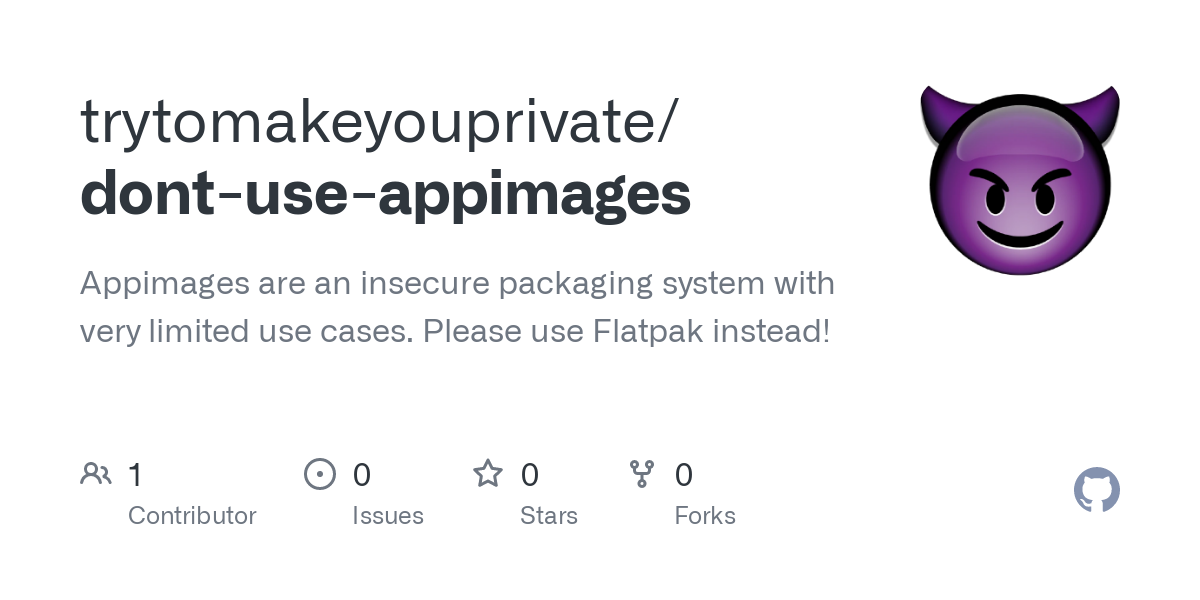Appimages totally suck, because many developers think they were a real packaging format and support them exclusively.
Their use case is tiny, and in 99% of cases Flatpak is just better.
I could not find a single post or article about all the problems they have, so I wrote this.
This is not about shaming open source contributors. But Appimages are obviously broken, pretty badly maintained, while organizations/companies like Balena, Nextcloud etc. don’t seem to get that.



Hehe, No. It’s the sandboxing.
But with this approach you take over the answering questions to newbies… Why doesn’t the webcam show up in the videoconferencing? Why doesn’t my GTK / QT themes apply to some software and it’s a 2 page tutorial with lots of command line commands to fix that? Why can’t I install Firefox add-ons and on Windows and MacOS everything just works? Why is Linux so complicated and regularly stuff doesn’t work?
I had this argument multiple times now. There is an easy solution: Do it the other way around until you know what you’re doing and about the consequences. Distributions are there for a reason. They put everything into one package and do testing to make sure everything works together. They provide you with security patches if you choose the right distro. LibreOffice and a Browser even come preinstalled most of the times. If you do away with all of that, it’s now your job to tie the software into your desktop, your job to handle the sandboxing if there is addons that need to pierce the sandbox. Your job to make sure the Flatpak publishers do quick updates and keep the runtimes up-to-date if a security vulnerability arise within an used library…
I’m not directly opposed to using Flatpak. I’m just saying there are some consequences that aren’t that obvious. There are valid use-cases and I also use Flatpak. But in my experience hyping some of the available technologies without simultaneously explaining the consequences is regularly doing a disservice to new users.
Do you mean fedora not installing codecs by default and the flatpak version of firefox has it bundled, i.e. just works?
I don’t want to argument with you about that. If something doesn’t work as expected or intended, you’ve done a bad job. Stuff not working on linux isn’t exclusive to flatpak. It’s the fault of maintainers if people complain about a flatpak version compared to distro package.
More people have to use flatpak and report the bugs they experience. The more people focus on flstpak the less infancy bugs will appear.
I’ve got only recent runtimes installed. There’s no old runtime. I understand your concern though, but it’s less of a problem for maintained software. Moreover, you’ve got the same problrm for other package manager. Flatpakcan even improve upon this because it’s bundled.
There’s also a distinction to be made if it’s an official distribution channel or if someone else packaged it.
I mean it’s not even my own problem. I just have Spotify, Microsoft Teams and Zoom installed that way, and a few pieces of software that I’m testing. I use a rolling distro so I have the most recent versions of every software I need anyways. And I have the skills to configure stuff. So I myself don’t have an use-case for a spyware-riddled Chrome browser from Flathub or something. I have a nice LibreWolf from the unstable channel of my distro. Steam and all the other stuff is there, too. And it works almost flawlessly. Why would I trade that in for a 4GB version of the same software that has downsides?
It’s the newer users I’m concerned with. Their sub-par experience of Linux.
This is what I mean:
As I said, it’s okay for someone like me - and probably you - to use, and I don’t complain. I’m glad I have Flatpak available as a tool. But look at the issues I’ve linked above and the steep learning curve for the beginner. They need to learn what GTK is, what QT is, what desktop they use, learn what Flatseal is, use the CLI. They have no clue why it is even required to do that much work to get their Keepass set up. And that it’s not Linux’ fault but their decision from 2 weeks ago to install the browser that way. And their experience is just worse than it needs to be. And this isn’t unsubstianced, I’m speaking from experience. I’ve answered these questions over and over again. It’s already annoying to get the NVidia stuff set up reliably, find new software and adapt your workflow. And the switch from X11 to Wayland broke things like screen sharing/recording, anyways. And we’re now piling 20 other things on top, to learn and do manually if you happen to be one of the users who don’t use the default standard setup.
And nothing of that is “bad” or can’t be fixed… We’re making progress with all of that. And we’ll get there. All I can say with my experience helping people with their Linux woes and the current state of Flatpak: The “use Flatpak for everything” mentality is causing issues for some newer users. And experience shows: They rarely understand the consequences but heard the hype about Flatpak. And few of them can explain why they used Flatpak over the proper packages in their distro.
So my opinion in short: